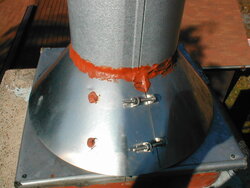Hey all... Today when I fired up my stove for the first time in two days(it was in the 50's this weekend), I noticed a little bit of water (maybe the size of a quarter or 1/2 dollar)puddled around the collar of my stove where the double wall pipe meets it. As we had a little rain this evening, I'm guessing its rain water coming down the flue?
Is this something that occasionally happens? It's the first time I've noticed it since the chimney was installed in early September. Should I be concerned or just keep an eye on it?
Chimney is a Selkirk Supervent from Lowes with their included "deluxe" chimney cap.
Is this something that occasionally happens? It's the first time I've noticed it since the chimney was installed in early September. Should I be concerned or just keep an eye on it?
Chimney is a Selkirk Supervent from Lowes with their included "deluxe" chimney cap.





 . Next dry day we get I'm gonna get up there. Just hope keeping it warm will help keep the stovetop dry and rust-free. It's kinda warm inside due to it being almost 60 outside today. Darn strange Christmas eve for northeast Ohio...
. Next dry day we get I'm gonna get up there. Just hope keeping it warm will help keep the stovetop dry and rust-free. It's kinda warm inside due to it being almost 60 outside today. Darn strange Christmas eve for northeast Ohio...